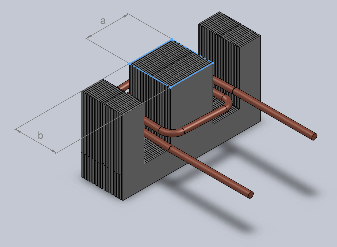In this page a simple method of calculating mains frequency closed-core power transformers. This is intended for home brewing, repairing and modifying transformers. Please remark that even if this method and some equations could be generalized, only classical cores composed by steel plates are taken into account.
The size of the core
When designing a closed-core power supply transformer, the first step is to choose a suitable core according to the power the device will have to handle. Usually, for high power, large cores are required. Actually, there is no theoretical or physical reason preventing a small core from handling a large power, but for practical reasons, on a small core, there is not enough space to fit all the windings: a large core is the only choice. In order to choose a pretty good core right form the beginning, the following empirical formula (for a working frequency of 50 Hz) can help:

This equation links the (apparent) power P to the core cross-section surface A, taking into account core efficiency η (Greek "eta"). When measuring the core cross-section, one should remove about 5% in order to take into account the thickness of the varnish on the ferromagnetic plates composing the core. The cross-section A is the minimum cross-section of the magnetic circuit, usually measured where the windings are located as shown in the drawing below:

The above diagram shows a double-loop core, which is by far the most common type of core because of its low leakage flux and small size. It's called "double-loop" because the magnetic field generated by the coils in the middle of the core loops half on the left part of the core and half on the right part. In this case, it's important to measure the core cross section inside the windings (as shown), where the flux is not splitted in half. If your transformer is has a single magnetic loop, like a toroidal transformer, than the cross section is the same all around the core and it doesn't matter where you measure it.
The efficiency depends on the material composing the core; if not known, the table below will give a rough idea:
| Core plate material | Magnetic flux density φ [Wb/m2] |
Core efficiency η [1/1] |
| Grain-oriented silicon steel (C-shaped), M5 | 1.3 | 0.88 |
| Grain-oriented silicon steel (0.35 mm plates), M6 | 1.2 | 0.84 |
| Non grain-oriented silicon medium steel (0.5 mm plates), M7 | 1.1 | 0.82 |
| Non grain-oriented silicon standard steel (or for heavy duty) | 1.0 | 0.80 |
| Mild steel | 0.8 | 0.70 |
Δείτε ολο το άρθρο εδώ:
https://www.giangrandi.org/electronics/trafo/trafo.shtml

Δεν υπάρχουν σχόλια:
Δημοσίευση σχολίου
Το blog TEO O ΜΑΣΤΟΡΑΣ ουδεμία ευθύνη εκ του νόμου φέρει σχετικά σε άρθρα που αναδημοσιεύονται από διάφορα ιστολόγια. Δημοσιεύονται όλα για την δική σας ενημέρωση.